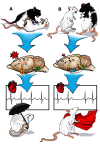Individual differences in the neurobiology of social stress: implications for depression-cardiovascular disease comorbidity
- PMID: 24669213
- PMCID: PMC3964750
- DOI: 10.2174/1570159X11666131120224413
Individual differences in the neurobiology of social stress: implications for depression-cardiovascular disease comorbidity
Abstract
Stress initiates a cascade of complex neural and peripheral changes that promote healthy adaption to stress, but when unabated, leads to pathology. Fascinating individual differences arise in the ability to cope with a stressor, rendering an individual more or less likely to develop stress-induced pathologies such as depression, anxiety, and cardiovascular disease. In this review we evaluate recent findings that investigate the neural underpinnings of adopting a passive or active coping response during social defeat stress. Because passive coping is associated with vulnerability to stress-related pathologies and active coping confers resiliency, understanding neurobiological adaptations associated with these diverse coping strategies may reveal biomarkers or targets impacting stress susceptibility. The co-occurrence of stress-induced depression and cardiovascular disease is becoming increasingly clear. Therefore this review focuses on the central mechanisms capable of contributing to psychopathology and cardiovascular disease such as corticotropin releasing factor, neuropeptide Y, monoamines, cytokines and oxidative stress. The impetus for this review is to highlight neurobiological systems that warrant further evaluation for their contribution to the pathophysiology of depression-cardiovascular disease comorbidity.
Keywords: Resident-intruder paradigm; coping; corticotropin releasing factor; dorsal raphe.; locus coeruleus.
Figures

References
-
- Campayo A, Gomez-Biel CH, Lobo A. Diabetes and depression. Curr. Psychiatry Rep. 2011;13(1):26–30. - PubMed
-
- Fenton WS, Stover ES. Mood disorders: cardiovascular and diabetes comorbidity. Curr. Opin. Psychiatry. 2006;19(4):421–427. - PubMed
-
- Folks DG. The interface of psychiatry and irritable bowel syndrome. Curr. Psychiatry Rep. 2004;6(3):210–215. - PubMed
-
- Stress AIo. In: http://www.stress.org/workplace-stress/
-
- Goldin R. Counting the costs of stress. In http://www.stats.org/ stories/2004/counting_costs_stress_sep23_04.htm. 2004
Grants and funding
LinkOut - more resources
Full Text Sources
Other Literature Sources
